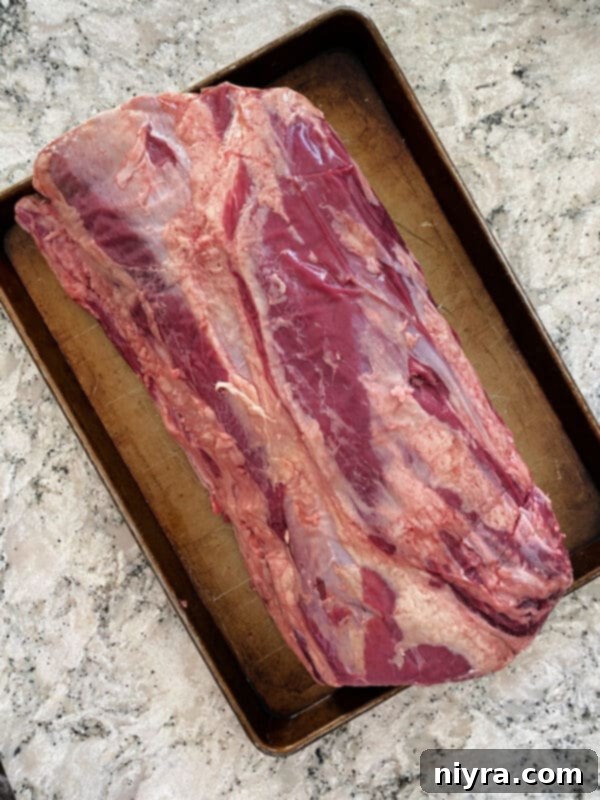Master the Perfect Italian Style Prime Rib Roast Every Time
Welcome to the ultimate guide for preparing an exquisite Italian Style Prime Rib Roast that promises to impress. Say goodbye to guesswork and hello to a culinary masterpiece. This tried-and-true recipe begins with a crucial sear, locking in juices, followed by a rich rub of aromatic Italian spices. The magic truly unfolds as the roast then cooks low and slow, ensuring unparalleled tenderness and a burst of flavor in every bite.
Discover the secrets to achieving a perfectly rare to medium-rare prime rib, where each slice is incredibly tender, juicy, and cooked just right. Our method also includes a clever technique to gently warm individual slices, ensuring every guest at your table enjoys their preferred level of doneness without compromising the roast’s integrity. Prepare to elevate your holiday meals and special occasions with this show-stopping center-piece.
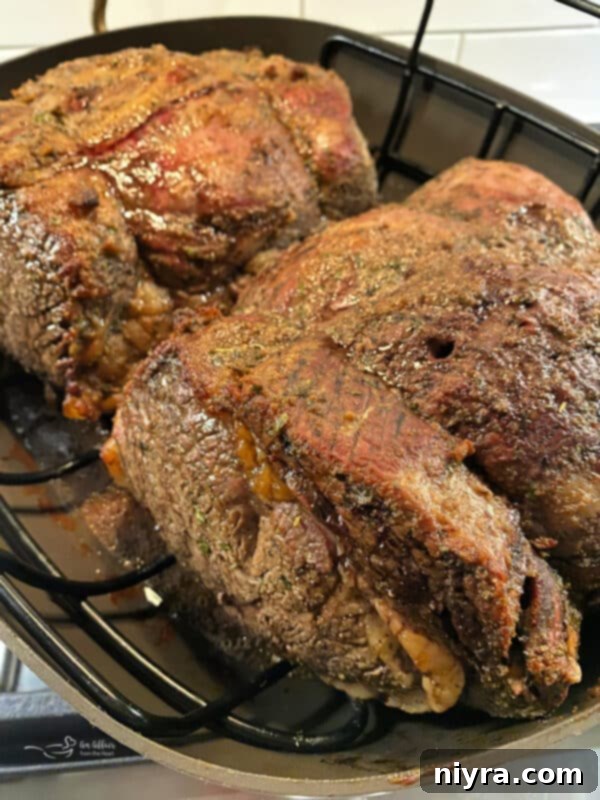
A Timeless Family Tradition: Our Beloved Prime Rib Roast
Prime rib isn’t just a meal; it’s a celebration, a centerpiece around which cherished memories are made. This Italian Style Prime Rib Roast holds a special place in my heart, a recipe passed down from my wonderful Mother-in-Law and Father-in-Law. It evokes vivid recollections of joyous Christmas gatherings at their picturesque farm in Iowa, a tradition that became the highlight of our holiday season each year.
My Father-in-Law, Denny, who we sadly lost in 2018, was the heart of these gatherings. His absence is deeply felt every day by all of us who loved him. Yet, his legacy lives on through this magnificent prime rib. We proudly continue his holiday tradition, ensuring that this flavorful roast graces our table, filling our home with warmth, love, and the delicious aroma that defined our family Christmases. It’s a tradition I passionately hope my children will embrace and carry forward for generations to come, keeping Denny’s spirit alive through shared meals and treasured moments.
My Original Story from 2012: The Foundation of a Culinary Legacy
Even as I update this beloved recipe post, some things are too precious to change. For sentimental reasons, the original narrative from 2012 remains, a snapshot in time that captures the essence of this culinary journey. Feel free to read through it, or if you’re eager to get cooking, simply scroll down to the printable recipe card below.
No, your eyes are not deceiving you! That astonishing sight is indeed 24 pounds of prime rib, a testament to the generous spirit of my in-laws. For every Christmas dinner, they unfailingly prepared this magnificent roast, a tradition that shaped my understanding of truly exceptional food. Before experiencing their prime rib, I had never tasted it in my life. What an introduction it was!
After that first incredible meal, I would occasionally try to order prime rib at restaurants, only to be met with profound disappointment. Nothing, absolutely nothing, compared to the perfection my in-laws created. They simply did it best, a culinary standard that I’ve strived to replicate ever since. But then again, I shouldn’t have been surprised. In the lottery of mothers and fathers-in-law, I genuinely hit the jackpot. They are an extraordinary family, and I thank God for their presence in my life every night.
Denny, my dear Father-in-Law, had a wonderful sense of humor and loved reading my blog. He’d get an enormous kick out of me taking pictures of food during their visits, often playfully nudging me with, “Don’t ‘cha wanna take a picture of that one, Kala?” This particular year, I decided it was time to meticulously document their prime rib making process, with a little help from my husband. If you aspire to create a prime rib that will truly wow your guests, a meal they’ll talk about for years, then prepare to learn the secrets!
Denny skillfully cuts off a few steaks to ensure the substantial roast fits perfectly in the pan.
These choice steaks are destined for the freezer, to be enjoyed on another special occasion.
Brian, my husband, lends a hand to his parents, diligently applying the fragrant herb and spice rub after the meat has been perfectly seared.
Denny expertly trims the fat from the roast and begins the carving process. A thoughtful touch: he keeps an electric frying pan filled with au jus warmed on the side, ready to cook slices a little longer for those who prefer their meat less pink.
Essential Ingredients for Your Italian Style Prime Rib Roast
Crafting an unforgettable prime rib begins with selecting the finest ingredients. While the full measurements and detailed instructions are available in the printable recipe card at the bottom of this post, here’s a closer look at what you’ll need and why each component is vital for this exceptional Italian Style Prime Rib Roast.
- 4-5 pound bone-in prime rib roast: The star of our show! When selecting your roast, a bone-in cut is highly recommended as the bones add incredible flavor and act as a natural rack, promoting even cooking. Your local butcher is an invaluable resource for choosing the best roast and can assist with any trimming. Beef is graded based on marbling (intramuscular fat), which directly impacts tenderness and flavor. Look for Prime grade, which boasts at least 8% intramuscular fat, making it the most tender and flavorful. Choice grade is a good second option, offering good quality and marbling, while Select grade is leaner and typically less tender. For a truly memorable experience, opt for Prime if available.
- Worcestershire Sauce: This savory condiment plays a crucial role. Its unique blend of flavors, including tamarind, anchovies, and vinegar, adds a depth of umami to the roast, enhances the beefy flavor, and helps tenderize the surface of the meat before the spice rub is applied.
- Herb and Spice Mix: This carefully balanced blend is what gives our prime rib its distinctive “Italian Style” character.
- Dried parsley flakes: Adds a fresh, herbaceous note.
- Basil: A quintessential Italian herb, providing a sweet, peppery aroma.
- Black pepper: Essential for a pungent, spicy kick that complements rich meats.
- Italian seasoning: A convenient blend, typically containing oregano, thyme, rosemary, and marjoram, reinforcing the Mediterranean flavor profile.
- Kosher salt: Crucial for seasoning the meat thoroughly, drawing out moisture, and creating that delicious crust.
- Garlic powder: Offers a concentrated, savory garlic flavor that penetrates the meat deeply.
- Onion salt: Provides a balanced oniony flavor and additional seasoning, contributing to a savory crust.

- Au Jus Mix: While we’ll create a delicious homemade au jus from the drippings, having a McCormick au jus packet (my personal favorite brand) on hand is perfect for supplementing or for those who desire extra. It ensures you have plenty of rich, savory sauce to serve with your prime rib.
- Beef bouillon cube: Dissolved in 1 cup of water, this forms the flavorful base for our homemade au jus, enhancing the beefy essence from the pan drippings. Alternatively, a cup of high-quality beef broth or beef stock can be used for an even richer flavor.
Crafting the Perfect Italian Style Prime Rib: Step-by-Step Guide
Follow these detailed steps to create a prime rib roast that is beautifully seared, wonderfully aromatic, and incredibly tender. Precision in temperature and timing is key to achieving that perfect doneness.

Step 1: Bring to Room Temperature and Initial Sear
Before cooking, it’s crucial to take your prime rib roast out of the refrigerator and allow it to come to room temperature for at least 1-2 hours. This ensures more even cooking throughout the roast. Place the meat, fat side up, on a rack in an ungreased shallow roasting pan. Preheat your oven to a high temperature of 450 degrees F (230°C) and bake the roast for 15 minutes. This initial high-heat searing creates a beautiful, flavorful crust on the exterior, locking in the juices and contributing to the roast’s overall richness.
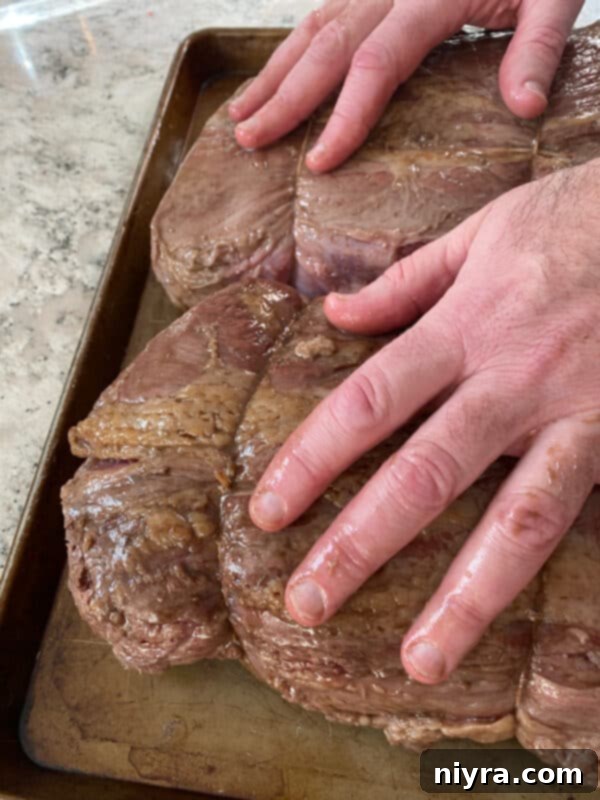
Step 2: Apply Worcestershire and Herb & Spice Rub
After the initial sear, carefully remove the roast from the oven. While it’s still warm, generously rub the entire surface of the meat with Worcestershire Sauce. In a small bowl, combine your dried parsley flakes, basil, black pepper, Italian seasoning, kosher salt, garlic powder, and onion salt. This aromatic blend is the heart of our “Italian Style” flavor. Evenly sprinkle and rub this potent spice mixture over all sides of the prime rib, ensuring every inch is coated. The warmth of the roast will help the rub adhere and infuse its flavors.
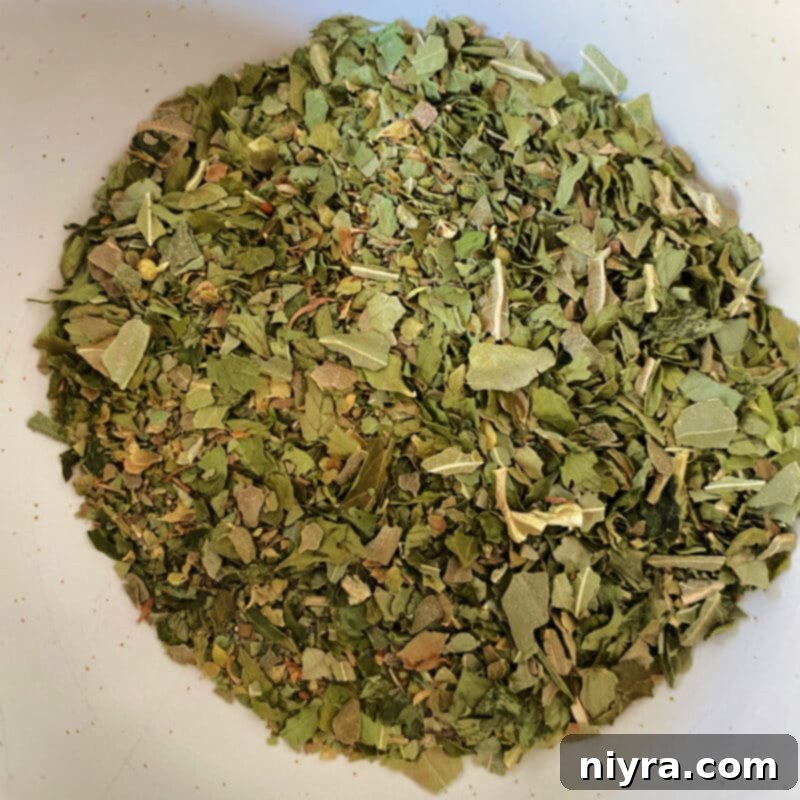
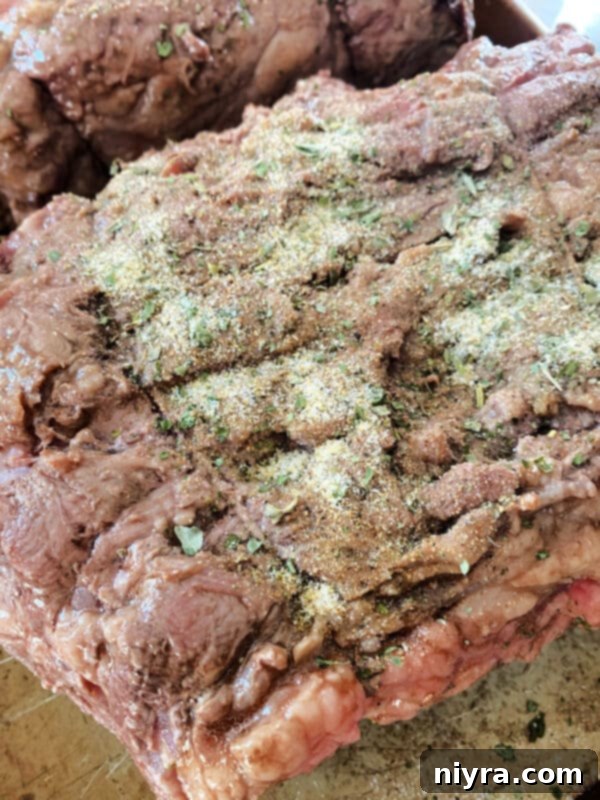
Step 3: Low and Slow Roasting for Ultimate Tenderness
Now, reduce your oven temperature to a gentle 250 degrees F (120°C). Return the seasoned roast to the oven and continue cooking for approximately 15 minutes per pound. This “low and slow” method is key to achieving incredibly tender meat and a perfectly medium-rare result. To ensure accuracy, use an instant-read meat thermometer inserted into the thickest part of the roast, avoiding the bone. For a medium-rare prime rib, aim for an internal temperature of 115-120 degrees Fahrenheit (46-49°C). Keep in mind that the roast will continue to cook and rise by 5-10 degrees during the crucial resting period.
Once your prime rib reaches the desired internal temperature, remove it from the oven, tent it loosely with foil, and let it rest for at least 15-20 minutes before carving. This resting period allows the juices to redistribute throughout the meat, ensuring every slice is incredibly moist and flavorful.
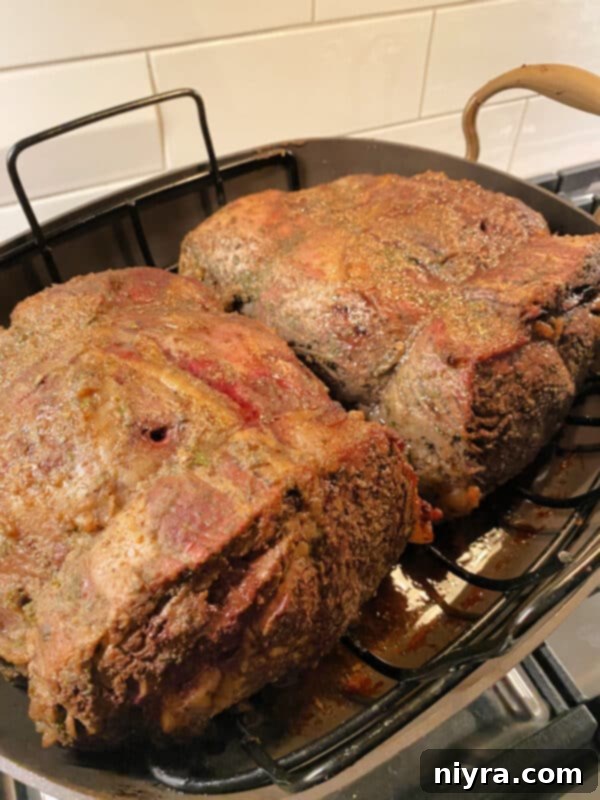
Creating the Perfect Au Jus
A rich, savory au jus is the perfect accompaniment to your prime rib. To make your own homemade au jus, carefully skim any excess fat from the drippings accumulated in your roasting pan. Return the remaining flavorful drippings to the pan. Dissolve one beef bouillon cube in 1 cup of hot water (or use 1 cup of beef broth/stock) and combine this with the drippings. Simmer gently, scraping up any browned bits from the bottom of the pan to incorporate maximum flavor. This creates a deeply savory, natural sauce.
For extra au jus, or if you prefer a simpler approach, McCormick au jus packets are an excellent option. Simply prepare them according to the package instructions. We often use a combination of homemade and packet au jus to ensure there’s plenty for everyone.
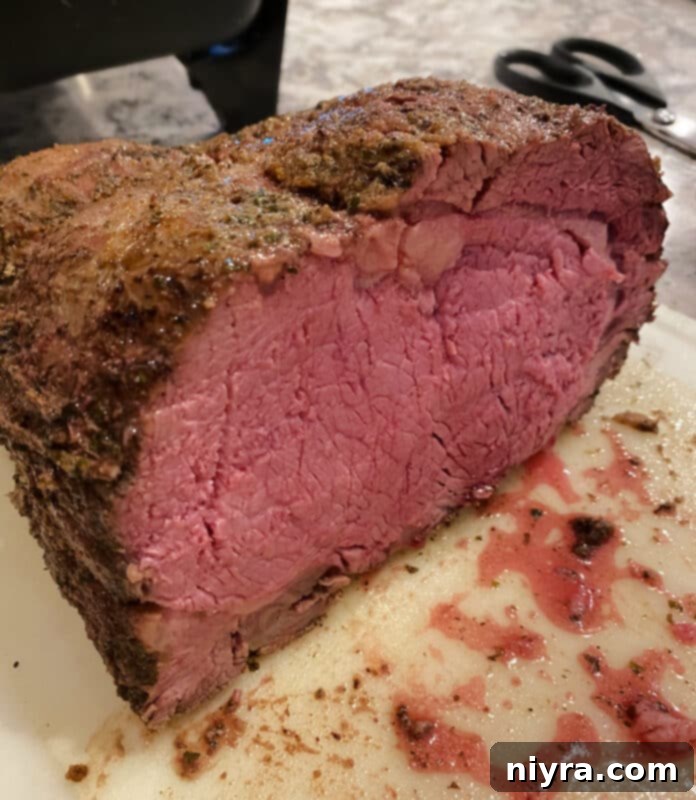
For guests who prefer their prime rib more well-done, we employ a fantastic trick: we heat the extra au jus in an electric skillet. As we carve the roast, individual slices can be briefly dipped into the hot au jus. This quickly brings the meat up to their preferred temperature without overcooking or drying out the entire roast. It only takes a couple of seconds and ensures everyone enjoys their prime rib exactly how they like it.
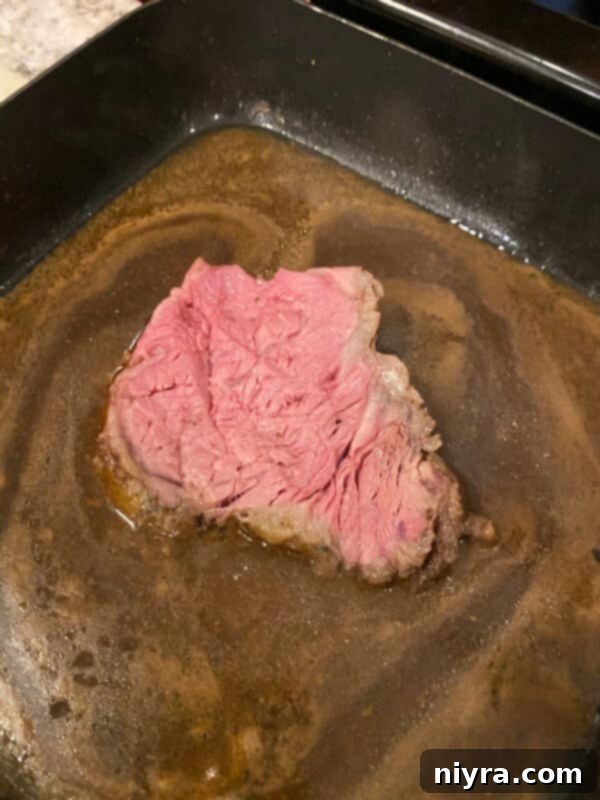
Enhance Your Feast: FAQs About Prime Rib
For those curious about the nuances of this magnificent cut of beef, here are answers to some frequently asked questions that will help you become a prime rib connoisseur.
What is the difference between prime rib and standing rib roast?
The terms “prime rib” and “standing rib roast” are often used interchangeably, but there’s a subtle distinction. “Standing rib roast” primarily refers to the cooking method – the roast is cooked standing upright on its rib bones, which act as a natural rack. “Prime rib,” on the other hand, refers to a specific cut of beef from the rib section of the cow. A true prime rib comes from ribs 6 to 12 and is considered the best section for flavor and tenderness. Cuts outside these numbers might be called a “rib roast” but technically not “prime rib.” Prime rib will always include the rib bones, while a general rib roast may or may not be bone-in.
What cut of meat is prime rib?
Prime rib, also known as a standing rib roast, is a highly prized cut of beef sourced from the primal rib section of the cow. This area, located between the chuck and loin, is known for its rich marbling and tenderness. A whole prime rib typically consists of 6 to 7 ribs (ribs 6 through 12) and can weigh anywhere from 12 to 16 pounds. It’s sometimes referred to as a top loin or rib-eye roast. Ribeye steaks, renowned for their flavor and tenderness, are cut from the prime rib roast.
How is prime rib best cooked?
Prime rib is widely considered best when cooked to a rare or medium-rare doneness. This ensures the meat remains incredibly juicy, tender, and succulent with a flavorful crust. Traditionally, it’s slow-roasted to achieve an even cook. The ideal internal temperature for prime rib served medium-rare is typically between 125-130°F (52-54°C) after resting, though some prefer it rarer (120-125°F or 49-52°C) or medium (130-135°F or 54-57°C). Resting the roast after cooking is crucial, allowing the juices to redistribute for maximum moisture. While a “prime” method involves searing at a high temperature (like 450°F) then reducing to 325°F, our “gourmet” low-and-slow method at 250°F for a longer period consistently yields superior tenderness and doneness control.
Expert Tips & Tricks for a Flawless Prime Rib Experience
Elevate your prime rib dinner from excellent to extraordinary with these helpful tips and tricks:
- Enhance Your Au Jus: Don’t hesitate to use additional store-bought au jus packets if you need more sauce or want to deepen the flavor of your homemade drippings. Blend them together for a rich, abundant accompaniment.
- Creamy Horseradish Sauce: Many connoisseurs consider horseradish sauce an essential pairing with prime rib. You can easily whip up your own creamy version with a few simple ingredients for a piquant contrast to the rich beef.
- Perfect Side Dishes: A magnificent prime rib deserves equally impressive side dishes. Some of my top recommendations include Potatoes Au Gratin, Cauliflower Gratin, or classic Mashed Potatoes. And, of course, a robust glass of red wine is an absolute must to complete the gourmet experience.
- Leftovers Reinvented: Should you be fortunate enough to have prime rib leftovers, store them in an airtight container in the refrigerator for 3-5 days. For longer storage, cooked prime rib freezes beautifully for up to 6 months. Repurpose leftovers into delectable sandwiches, flavorful soups, or transform them into a hearty batch of beef tips and gravy for another satisfying meal.
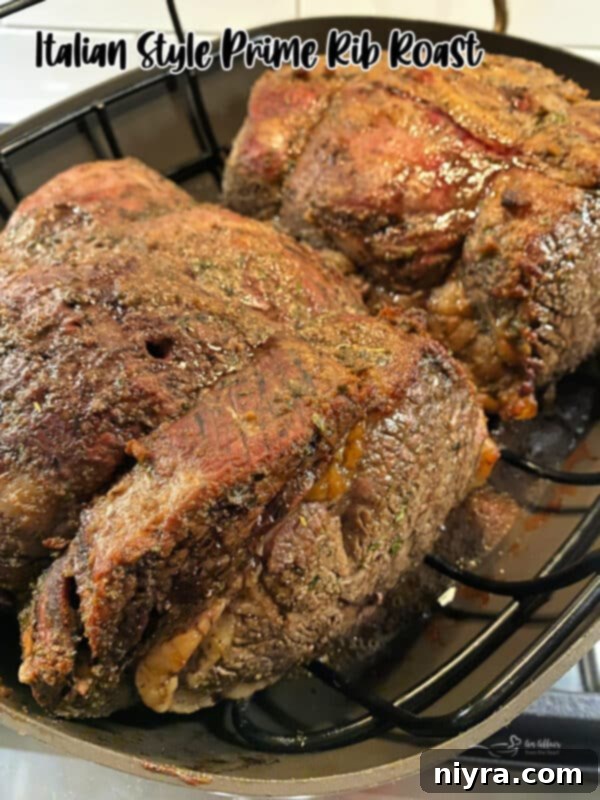
Share the Love: Pin This Recipe!
If you’re as excited about this Italian Style Prime Rib Recipe as I am, don’t let it get lost! Be sure to pin it to your favorite Pinterest recipe board so you can easily find it whenever a special occasion calls for an extraordinary meal!
I sincerely hope you and your loved ones cherish this cherished family recipe as much as we do. This straightforward yet spectacular recipe for Italian Style Prime Rib is destined to become a beloved favorite for your holiday dinners and any special occasion demanding an unforgettable feast!

Italian Style Prime Rib Roast Recipe
Like this recipe?
Don’t forget to give it a ⭐️⭐️⭐️⭐️⭐️ star rating and
leave a comment below the recipe!
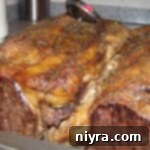
Italian Style Prime Rib Roast
A tried-and-true recipe for a succulent Italian Style Prime Rib Roast, perfectly seasoned with Worcestershire and Italian spices, cooked to tender perfection.
Print Recipe
Prep Time: 5 mins
Cook Time: 1 hr 15 mins
Total Time: 1 hr 20 mins
Course: Beef
Cuisine: American
Keyword: Italian Style Prime Rib Roast
Servings: 4-5 lb Roast
Calories: 9702 kcal (Note: Nutritional values are estimates and can vary significantly based on ingredients and portion sizes.)
Author: Michaela Kenkel
Equipment
- Thermapen ONE (Instant-Read Thermometer)
- Roasting Pan with Rack
- Electric Skillet (optional, for warming slices)
Ingredients
- 4-5 pound Prime Rib Roast (bone-in recommended)
- 1 Tbsp Worcestershire Sauce
- 1/4 teaspoon each: dried parsley flakes, basil, black pepper, Italian seasoning
- 1 teaspoon Kosher salt
- A generous sprinkling of garlic powder and onion salt
- 1 beef bouillon cube dissolved in 1 cup of water (or 1 cup beef broth/stock)
- Au Jus Packet for extra (if desired)
Instructions
- Preheat your oven to 450 degrees F (230°C).
- Remove the prime rib roast from the refrigerator and allow it to come to room temperature for at least 1-2 hours before cooking.
- In a small bowl, thoroughly mix together the dried parsley flakes, basil, black pepper, Italian seasoning, and kosher salt. Set this aromatic herb and spice blend aside.
- Place the prime rib roast, fat side up, on a rack in an ungreased shallow roasting pan. Bake at 450 degrees F (230°C) for 15 minutes. This initial high heat searing will create a flavorful, crusty exterior.
- After the searing step, reduce the oven temperature to 250 degrees F (120°C).
- Carefully remove the roast from the oven. Rub the entire surface of the prime rib with Worcestershire sauce. Then, generously sprinkle and rub in the garlic powder and onion salt. Finally, apply the prepared herb and spice mixture evenly over all sides of the roast, ensuring it adheres well.
- Return the seasoned roast to the oven and continue cooking at 250 degrees F (120°C) for approximately 15 minutes per pound. This “low and slow” method will result in a perfectly medium-rare roast. Use an instant-read digital meat thermometer to monitor the internal temperature. Aim for 115-120 degrees Fahrenheit (46-49°C) for medium-rare when you remove it from the oven. Remember to let the roast rest for at least 15-20 minutes after removing it from the oven (tent loosely with foil) to allow the juices to redistribute. The internal temperature will rise by 5-10 degrees during this resting period.
- To make your own Au Jus: Skim any excess fat from the flavorful drippings collected in the roasting pan. Return the drippings to the pan. Dissolve the beef bouillon cube in 1 cup of hot water (or use 1 cup of beef broth/stock) and add it to the drippings. Simmer gently, scraping up any browned bits from the bottom of the pan to infuse maximum flavor.
- For extra Au Jus, just use McCormick au jus packets, preparing them according to their package instructions.
- For guests who prefer their prime rib more well-done, heat the extra au jus in an electric skillet. As you carve the roast, add the desired slices to the hot au jus for a couple of seconds to gently bring them up to temperature without drying out the meat.
Notes
When preparing a larger roast, remember to proportionally increase the amount of seasonings. If you are cooking multiple sections of prime rib (e.g., two 10-pound roasts rather than one 20-pound roast), base the cooking time on the weight of the individual, smaller sections, not the total combined weight of all roasts.
Nutrition
Serving: 1 | Calories: 9702kcal | Carbohydrates: 13g | Protein: 578g | Fat: 798g | Saturated Fat: 330g | Polyunsaturated Fat: 377g | Cholesterol: 2143mg | Sodium: 5986mg | Fiber: 4g | Sugar: 3g
Note: Nutritional information is an estimate calculated by a third-party service and may vary based on specific ingredients, portion sizes, and preparation methods.
This recipe was originally posted on January 4, 2012. It has been updated to improve user experience and reshared on December 21, 2022.

